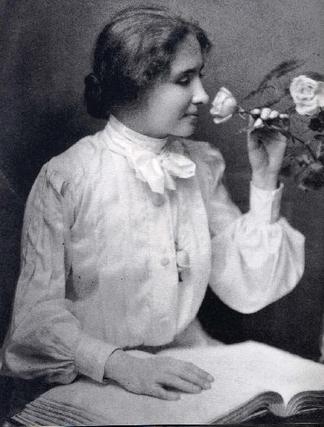Helen Keller (Author/Lecturer/Human Rights Campaigner/Pacifist)
 Helen Adams Keller (June 27, 1880–June 1, 1968) was an American author, political activist, and lecturer. She was the first deafblind person to earn a Bachelor of Arts degree. The story of how Keller's teacher, Anne Sullivan, broke through the isolation imposed by a near complete lack of language, allowing the girl to blossom as she learned to communicate, has become known worldwide through the dramatic depictions of the play and film The Miracle Worker.
Helen Adams Keller (June 27, 1880–June 1, 1968) was an American author, political activist, and lecturer. She was the first deafblind person to earn a Bachelor of Arts degree. The story of how Keller's teacher, Anne Sullivan, broke through the isolation imposed by a near complete lack of language, allowing the girl to blossom as she learned to communicate, has become known worldwide through the dramatic depictions of the play and film The Miracle Worker.
A prolific author, Keller was well traveled, and was outspoken in her opposition to war. A member of the Socialist Party USA and the Wobblies, she campaigned for women's suffrage, workers' rights, and socialism, as well as many other leftist causes.
Helen Adams Keller was born on June 27, 1880, in Tuscumbia, Alabama. Her family lived on a homestead, Ivy Green, that Helen's grandfather had built decades earlier. Helen's father, Arthur H. Keller, spent many years as an editor for the Tuscumbia North Alabamian and had served as a captain for the Confederate Army. Helen's paternal grandmother was the second cousin of Robert E. Lee. Helen's mother, Kate Adams, was the daughter of Charles Adams. Though originally from Massachusetts, Charles Adams also fought for the Confederate Army during the American Civil War, earning the rank of brigadier-general.
Helen's father's lineage can be traced to Casper Keller, a Switzerland native. Coincidentally, one of Helen's Swiss ancestors was the first teacher for the deaf in Zurich. Helen reflects upon this coincidence in her first autobiography, stating "that there is no king who has not had a slave among his ancestors, and no slave who has not had a king among his."
Helen Keller was not born blind and deaf; it was not until she was 19 months old that she contracted an illness described by doctors as "an acute congestion of the stomach and the brain", which might have been scarlet fever or meningitis. The illness did not last for a particularly long time, but it left her deaf and blind. At that time, she was able to communicate somewhat with Martha Washington, the six-year-old daughter of the family cook, who understood her signs; by the age of seven, she had over 60 home signs to communicate with her family. According to Soviet psychologist A. Meshcheryakov, Martha's friendship and teaching was crucial for Helen's later development.
In 1886, her mother, inspired by an account in Charles Dickens' American Notes of the successful education of another deaf and blind child, Laura Bridgman, dispatched young Helen, accompanied by her father, to seek out Dr. J. Julian Chisolm, an eye, ear, nose, and throat specialist in Baltimore, for advice. He subsequently put them in touch with Alexander Graham Bell, who was working with deaf children at the time. Bell advised the couple to contact the Perkins Institute for the Blind, the school where Bridgman had been educated, which was then located in South Boston. Michael Anaganos, the school's director, asked former student Anne Sullivan, herself visually impaired and only 20 years old, to become Keller's instructor. It was the beginning of a 49-year-long relationship, evolving into governess and then eventual companion.
Anne Sullivan arrived at Keller's house in March 1887, and immediately began to teach Helen to communicate by spelling words into her hand, beginning with d-o-l-l for the doll that she had brought Keller as a present. Keller's big breakthrough in communication came the next month, when she realized that the motions her teacher was making on the palm of her hand, while running cool water over her other hand, symbolized the idea of "water"; she then nearly exhausted Sullivan demanding the names of all the other familiar objects in her world.
Due to a protruding left eye, Keller was usually photographed in profile. Both her eyes were replaced in adulthood with glass replicas for "medical and cosmetic reasons".
Keller went on to become a world-famous speaker and author. She is remembered as an advocate for people with disabilities amid numerous other causes. She was a suffragist, a pacifist, an opponent of Woodrow Wilson, a radical Socialist and a birth control supporter. In 1915 she and George Kessler founded the Helen Keller International (HKI) organization. This organization is devoted to research in vision, health and nutrition. In 1920 she helped to found the American Civil Liberties Union (ACLU). Keller and Sullivan traveled to over 39 countries, making several trips to Japan and becoming a favorite of the Japanese people. Keller met every U.S. President from Grover Cleveland to Lyndon B. Johnson and was friends with many famous figures, including Alexander Graham Bell, Charlie Chaplin and Mark Twain.